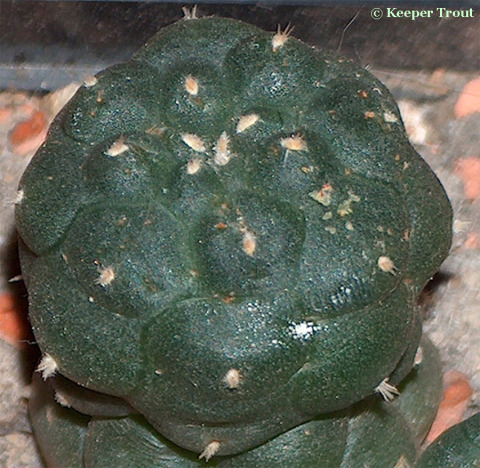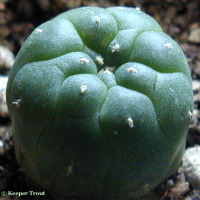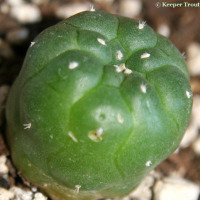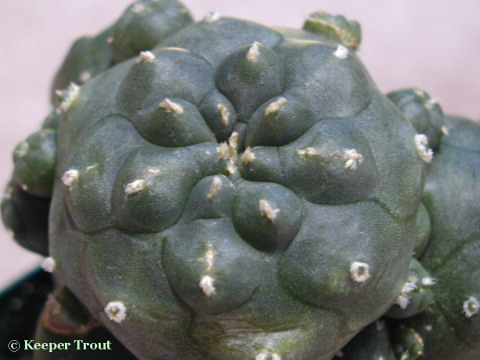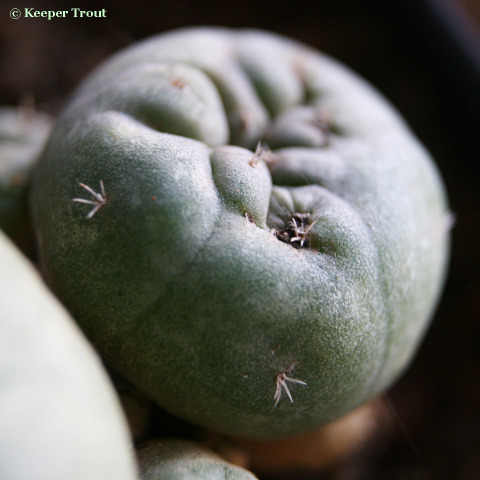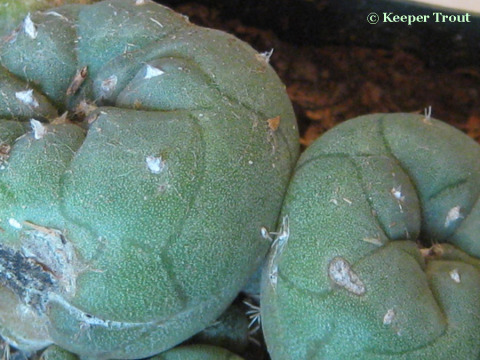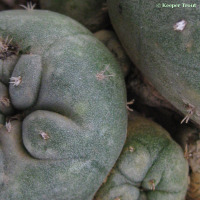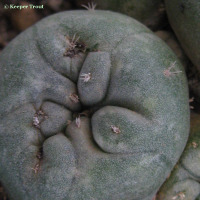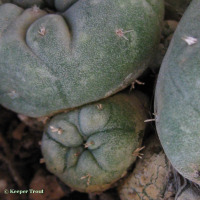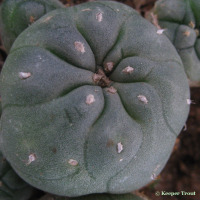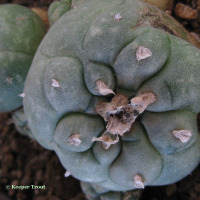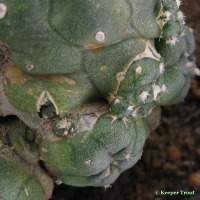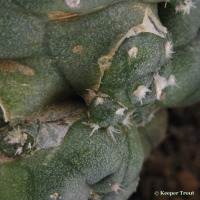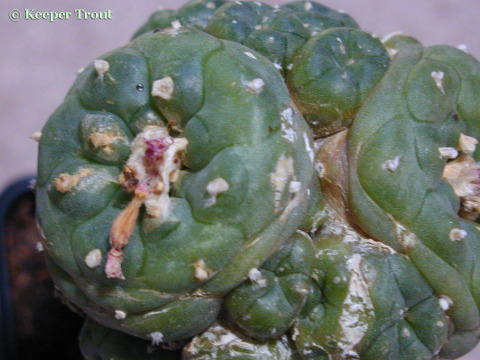Two images have been removed from this page pending confirmation that their identification was accurate. They will return to this website as soon as that information becomes available from their grower.
Lophophora jourdaniana Habermann
Also encounterable as Lophophora williamsii f. jourdaniana and Lophophora williamsii var. jourdaniana in horticulture.
This is not considered to be an accepted species. Or at least, it can’t be considered as such without someone first linking it to an actual population of wild plants.
Reported to contain mescaline in analysis and human bioassay.
Lophophora jourdaniana species nova
Habermann 1975a:
“Corpus molle, coloris coeruleo-viridis, plano globosum, cum apice modice depresso, ad 6 cm altum et ad 7 cm diametiens, ad basim abunde proliferans, cum radice rapiformi. Costae humiles, numero 7-8, modice spiraliter tortae, dividuntur fissura recta seu undulata. Podaria humilia in costis dividuntur fissura transversa brevi, solum in suprema costa conspicua. Areolae rotundae, 2-3 mm diametientes, 12-16 mm inter se distant. Areolae in caulibus iunioribus ferunt 4-8 exiguas firmas spinulas 2-3 mm metientes. Spinulae illae per nonnullos conservantus. In caulibus adultis areolae ferunt fasciculos densos pilorum sericorum alborum, ad 10 mm longorum, qui in planta suprema tegumentum densum formant. Flores infundibuliformes, ad 15 mm longi et 15 – 20 mm diametientes, ex areolis apicis emergunt. Pericarpellum nudum, subviride. Tubus brevis, infundibuliformiter dilatatur. Phylla perigonii exteriora lanceolata cum acumine firmo et stria media viride fusca. Phylla perigonii interiora lanceolata, cum margine integro, 3-4 mm lata, 10-14 mm longa, coloris roseo-violacei, cum stria media fusciore. Stylus roseus, 5 – 8 mm longus, cum 4- 6 stigmatibus albis. Stamina multa, cum filaminibus roseo-violaceis et cum antheres flavis stylum partim superant. Fructus roseus, 15 – 20 mm longus, 4 mm latus, claviformis, nudus, cum residuis perianthi siccatis in cauda. Semina galeriformia, 1,5 mm longa et 1,2 mm lata, quorum foramen micropylare vicinum hili basali cordati est, non differunt evidenter ab seminibus L. williamsii (Lem.) Court. Testa nigra, tuberculata. Embryon oviforme, modice applanatum, cum perispermio conspicuo.
Patria incerta, vero simile Mexico septentrionale.
Holotypus in herbario V. Habermanni (Facultas medica universitatis Carolinae, Plzeii) sub numero L-2.
L. jourdaniana non est cleistogama – non. foecundatur pollene floris eiusdem neque successerunt conati Lophophoram jourdanianam pollene Lophophorae williamsii (Lem.) Coult. aut eiusdem varietarum, neque pollene Lophophorae diffusae (Croiz.) Bravo, neque Lophophorae fricii (Habermann) foecundare.
L. jourdaniana ab lophophoribus ceteris descriptis roseo-violaceo colore perianthi, styli, filaminum staminum atque spinulis areolarum caulum iuniorum longae persistentibus differt.”
Lophophora jourdaniana Habermann
[Published in Habermann 1975a & 1975b]
Habermann 1975b pp 159-160:
“ Stem branching, depressed-globose, with sunken apex, up to 7 cm. diameter, 6 cm. high, bluish-green; roots large and fusiform; ribs 7-8, areoles nearly circular, 2-3 mm. diameter, mature stems with tufts of silky white hairs, without spines; young stems and branches with 4-8 feathery spines 2-3 mm. long, white, persistent for several years; flowers from areoles near the apex of the stem, 15 mm. long and 15-20 mm. diameter; pericarp naked, greenish, short pink tube funnelform; outer perianth segments oblanceolate, with greenish mid-stripe; inner segments oblanceolate, margin entire, 3-4 mm. broad, 10-14 mm. long, violet red with deep red mid-stripes; style pink, 5-8 mm. long; stigma lobes 4-6, white; stamens with pink-violet filaments and yellow anthers, longer than the style; fruit clavate, bare, 15-20 mm. long, 4 mm. in diameter, red, with dried perianth remains; seed black, papillate, 1.5 mm. long, 1.2 mm. broad, hilum broad, micropylar aperture at rostrum close to the hilum; embryo ovoid. Northern Mexico, limestone soils; exact locality not known. Holotype no. L-2.”
“ The habit of L. jourdaniana seems very close to that of L. williamsii at first glance, however there are some quite different features, such as long persistent spines at young stem areoles and the red perianth, style and filaments of the flowers.
The main features for recognition of Lophophora jourdaniana are small and persistent spines on young areoles and violet red flowers. Habermann 1975b
The use of the specific name “jourdaniana” is potentially misleading (and invalid) as it had been previously used for horticultural offerings. Initially ‘jourdaniana’ appeared as a name in an old Pierre Rebut catalog (Rebut Catalogue de Cactées et Plantes Grasses Diverses). I have not yet seen a copy.
Prior to Habermann’s usage there were 4 previous uses of this specific name in the literature. All were published in vague and unclear accounts (mostly nomen nudum);
1. Anhalonium jourdanianum (Rebut) Lewin [i.e. Anhalonium jourdanianum Rebut from the Rebut catalog; published in Lewin 1894], Anhalonium jourdanianus Hort. (in Rouhier’s 1927 Trav. Lab. Mat. Med. Phar. Galen 17:51 AKA Le Peyotl],
2. Echinocactus jourdanianus (Rebut) Rebut [Rebut 1905], Echinocactus jourdaniana (Rebut) Rebut ex Maass [in Maass 1905], Echinocactus lewinii (Hennins) Schumann var. jourdaniana Michaelis [Michaelis 1896]
3. Lophophora jourdaniana Kreuzinger syn. violaciflora [Kreuzinger1935]
4. Lophophora jourdaniana Lewin appeared in Kakteenkund 1937 5: 190] None can be linked to Habermann’s material with any degree of certainty. More recently there was the description as Lophophora williamsii f. jourdaniana Hansen [Hansen 1996]
Habermann’s assignment referred to a rose-violet flower color appearing in European imported & cultivated plants (arising from within lots of material identified as L. williamsii), while his actual description (and type) was based on a plant of Mexican origin in Europe which had been purchased by K.H. Ühlig (as L. williamsii) Habermann felt this plant looked like the same material as was already in European collections (again arising from within lots designated L. williamsii originating from Mexico or else what had been propagated in Europe from that material)
Therefore, this name, as Habermann described it, should be extended with caution to any earlier material referred to by the same name.
Habermann makes a baffling statement but perhap he simply mispoke:
“Moreover, this species is not cleistogamous and all attempts to achieve fertilization with pollen of other Lophophora species have failed as yet.”
Habermann’s comment on their unability to cross-pollinate this “species” with L. williamsii, its varieties, L. fricii or L. diffusa is countered by horticulturalists who have noted no such difficulty, for example M.S. Smith 1998, or who have commented on provisional difficulties (see http://www.cactus-art.biz)
Lophophora jourdaniana is not widely accepted and is rejected by Anderson. See Anderson 1980.
Despite it’s origin being as individuals culled out of unrelated lots of imported L. williamsii those persistent spines on young areoles, and the reddishness of petals, style and filaments merits a closer look. At least four separate clone lines are being propagated and maintained as such in Europe.
It is not clear how many exist but clearly they entered horticulture over a fairly broad period of time so keeping eyes open for wild plants seems prudent.
It might simply be a difference in how one defines colors but this author has never witnessed a jourdaniana with flowers that were “violet red with deep red mid-stripes.”
It is commonly proposed that Lophophora jourdaniana shows spines due to being a hybrid. This appears to lack any actual study but it would seem to be warranted. What may be noteable in the proposals is a lack of a plausible pollen parent.
Lophophora jourdaniana clones from Europe (JM)
- clone 2
- clone 3
- clone 4



